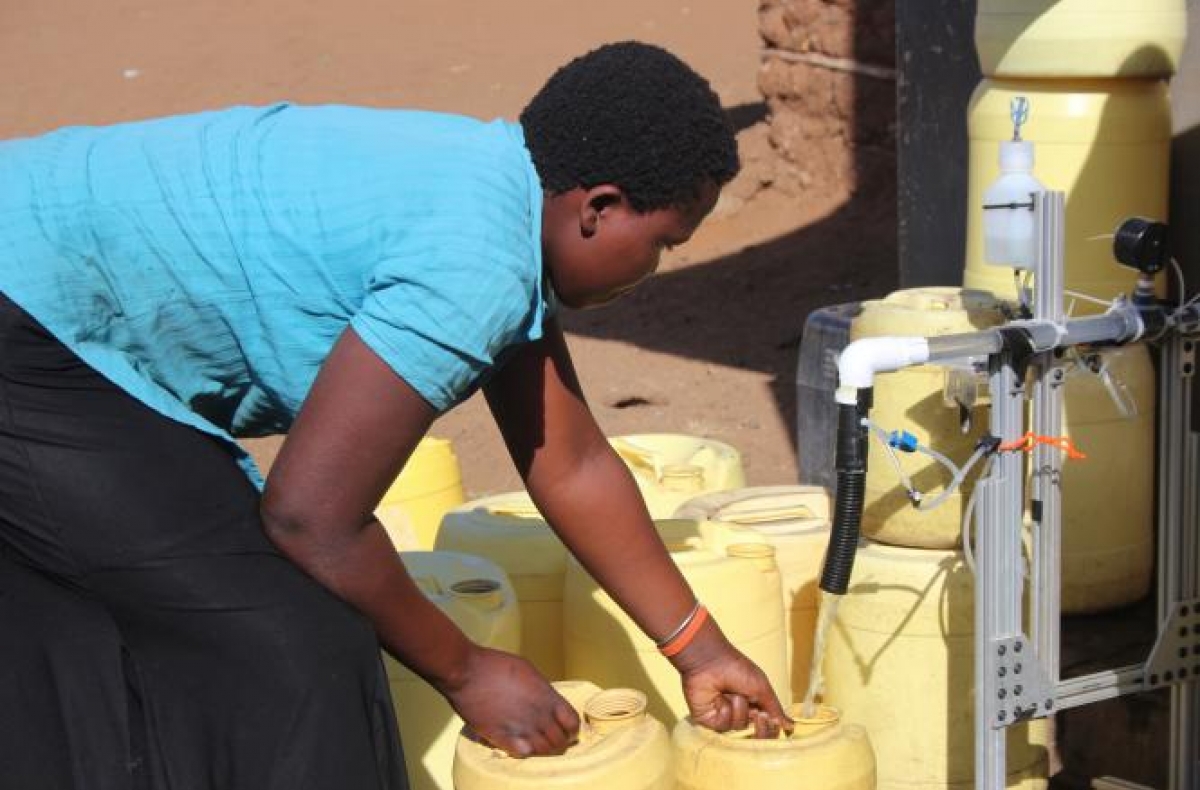Scaling up a solution
WHD researchers in Kisimu, Kenya are evaluating an automatic disinfection system that dispenses chlorine into water at public taps.
March 21, 2017

What if people in the world’s growing urban slums could affordably and easily access safe water? That’s the question WHD researchers seek to answer in Kisimu, Kenya, where they are evaluating an automatic disinfection system that dispenses chlorine into water at public taps.
The device, developed at Stanford and previously tested in Bangladesh, represents a new paradigm for water treatment that requires little behavioral change on the part of end users. The device has no moving parts, requires no electricity and would sell for $20 or less. Once attached to a water point, the device doses water with a precise amount of chlorine each time someone collects water. The chlorine residual protects against recontamination of water during transport and storage. This novel approach overcomes the challenges and high costs of centralized water treatment, while also removing the burden of having to treat water in people’s homes.
The issue could not be more pressing: globally, diarrhea caused by waterborne pathogens is the second leading killer of children under five, according to the World Health Organization. Population growth, climate change, untreated sewage and other challenges further complicate the situation. There is no way to build high quality piped systems with centralized treatment fast enough or affordably enough. Filters and additives designed for managing water quality in home have seen low uptake and inconsistent use.
“In the communities where we work, the limitations of both centralized and point-of-use treatment strategies were obvious,” said WHD faculty lead Jenna Davis, Associate Professor of Civil & Environmental Engineering at Stanford. “Point-of-collection disinfection seemed like an intermediate ‘sweet spot’ where we could ensure substantial improvements in household water quality while also avoiding the large behavior-change costs associated with in-home technologies.”
With funding from the Stanford Institute for Innovation in Developing Economies (SEED), WHD researchers are working with MSR Global Health and PATH to refine the concept – including a business model – and to create more effective prototypes. MSR is a for-profit company with deep technical design and manufacturing expertise, and decades of experience engineering water treatment technologies for outdoor and military use. PATH is an international nonprofit widely known for scaling up global health innovations for low-income settings. WHD and its partners aim to establish proof of concept for, and a strategy to scale up, the point-of-collection disinfection approach.
In addition to its collaboration with MSR and PATH, WHD is working with Deutsche Gesellschaft für Internationale Zusammenarbeit (GIZ), a German bilateral aid agency. GIZ has long worked to expand piped water supply services among Kenya's poor. Working with Kenya's Water Services Trust Fund, GIZ has supported the construction of water kiosks since 2006. GIZ staff contacted WHD last year when they became aware of the extent to which water quality deterioration between the point of collection and the point of use undermined the potential impact of their project, funded by the German government.
Seeing potential in chlorinator technology, GIZ started work with WHD to find scientific evidence the approach would lead to a reduction in contamination at the household level, according to GIZ program manager Dirk Schaefer. WHD helps GIZ with survey design and shares ongoing research findings.
“We hope that by combining our individual strengths in implementation and research, both GIZ and Stanford will benefit, and we can jointly contribute to achieving improvements in water quality at the point of consumption,” Schaefer said.
“We see our collaboration with GIZ and WSTF as a tremendous opportunity both to improve the quality of water that households use for drinking and cooking, and to understand the conditions under which point-of-collection disinfection is a cost-effective approach to ensuring safe water at the point of consumption,” Davis said.
Kenya is an ideal testing ground. The country ranks in the top 20 of the world’s nations in terms of urban growth rates. In part as a result of this rapid city growth, the percentage of urban dwellers with access to improved water supply services in Kenya has actually fallen. In addition, Kenyan households often purchase high-quality water for drinking and cooking, in contrast with households in Bangladesh. The relatively higher demand for safe water in Kenya, even among low-income households, could result in the point-of-collection disinfection device being even more affordable.
“We were excited to see if the proof of concept held up in a different context,” said Shreyan Sen, a Stanford graduate student on the WHD Kenya team who also worked on the Bangladesh project. Beyond the technology involved, economic and cultural aspects related to how people want the device to function and who pays are fascinating issues to explore, Sen said. “This is a unique historical moment, so we have to be innovative and think about how we’re going to get clean water to people in situations that may not look like the problems we have back home.”
The point-of-collection water disinfection project is the flagship of a broader Product Development Alliance (PDA) that the SEED grant to WHD helped establish. The PDA provides a platform for other Stanford research groups working on water-related technologies in the global South to engage with MSR Global and PATH on product development strategies. WHD will organize a related learning event that brings together Stanford researchers and PDA members together as part of the 2018 Bay Area WASH Symposium.
Contact Information
Rob Jordan
Associate Editor, Environment and Sustainability, Woods Institute
rjordan@stanford.edu


